Construction Defects: Concrete Material Science Research Report
VerifiedAdded on 2021/06/17
|8
|1596
|201
Report
AI Summary
This research paper focuses on a concrete construction defect, specifically a honeycomb defect, in the Sydney region. It begins with an introduction to concrete as a composite material, detailing its composition of cement, aggregates, and water, and the chemical process of hydration. The paper then outlines the functions of concrete, including its compressive strength, durability, and fire resistance. The core of the report investigates the honeycomb defect, describing its types, causes such as improper compaction and poor workability, and its detrimental effects on structural integrity. Finally, the paper proposes a solution involving the removal of the defective concrete, cleaning the surface, and applying non-shrink grout, followed by a post-grouting process with self-curing mortar. The paper concludes by summarizing the causes, effects, and solutions for the honeycomb defect, referencing relevant literature throughout.
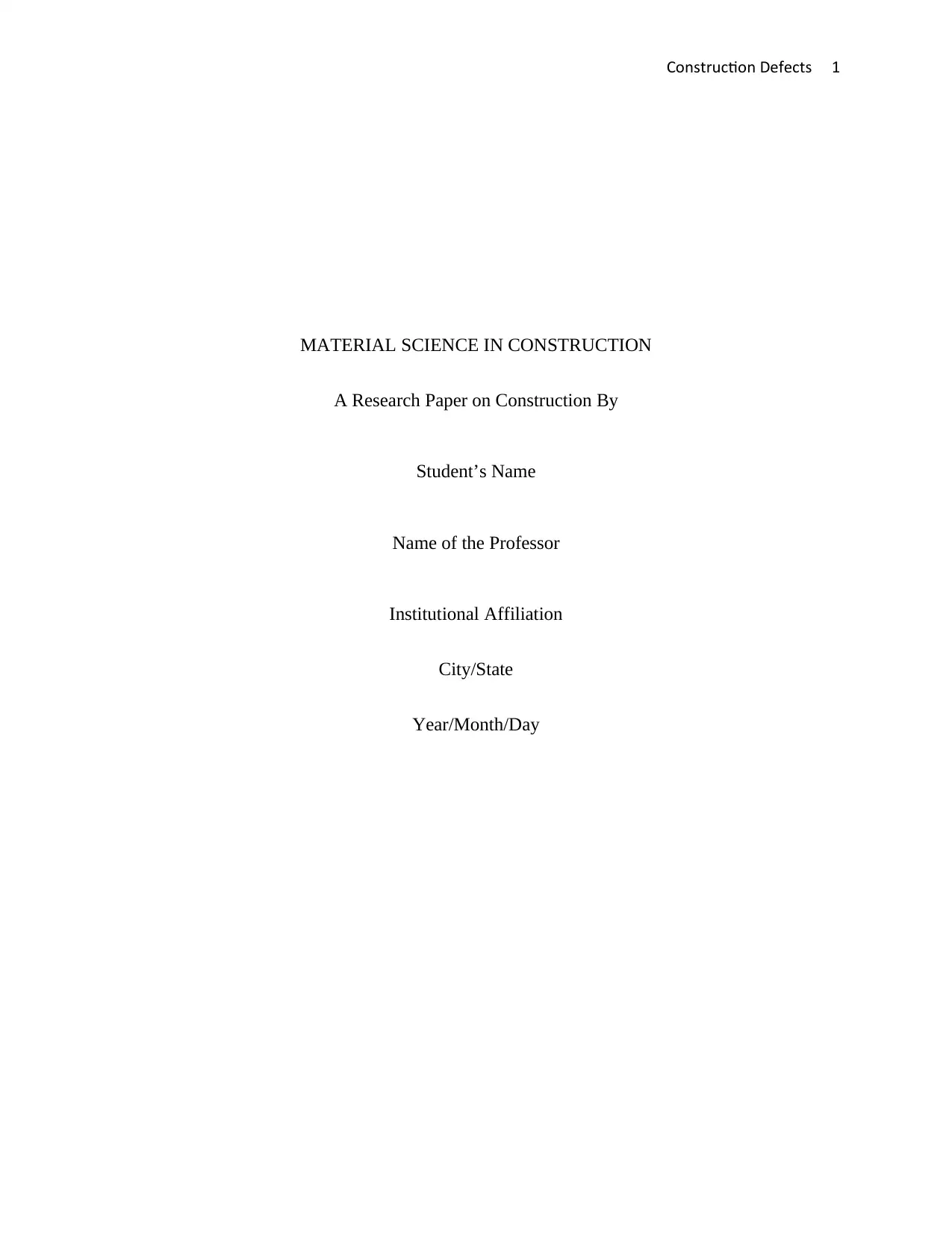
Construction Defects 1
MATERIAL SCIENCE IN CONSTRUCTION
A Research Paper on Construction By
Student’s Name
Name of the Professor
Institutional Affiliation
City/State
Year/Month/Day
MATERIAL SCIENCE IN CONSTRUCTION
A Research Paper on Construction By
Student’s Name
Name of the Professor
Institutional Affiliation
City/State
Year/Month/Day
Paraphrase This Document
Need a fresh take? Get an instant paraphrase of this document with our AI Paraphraser
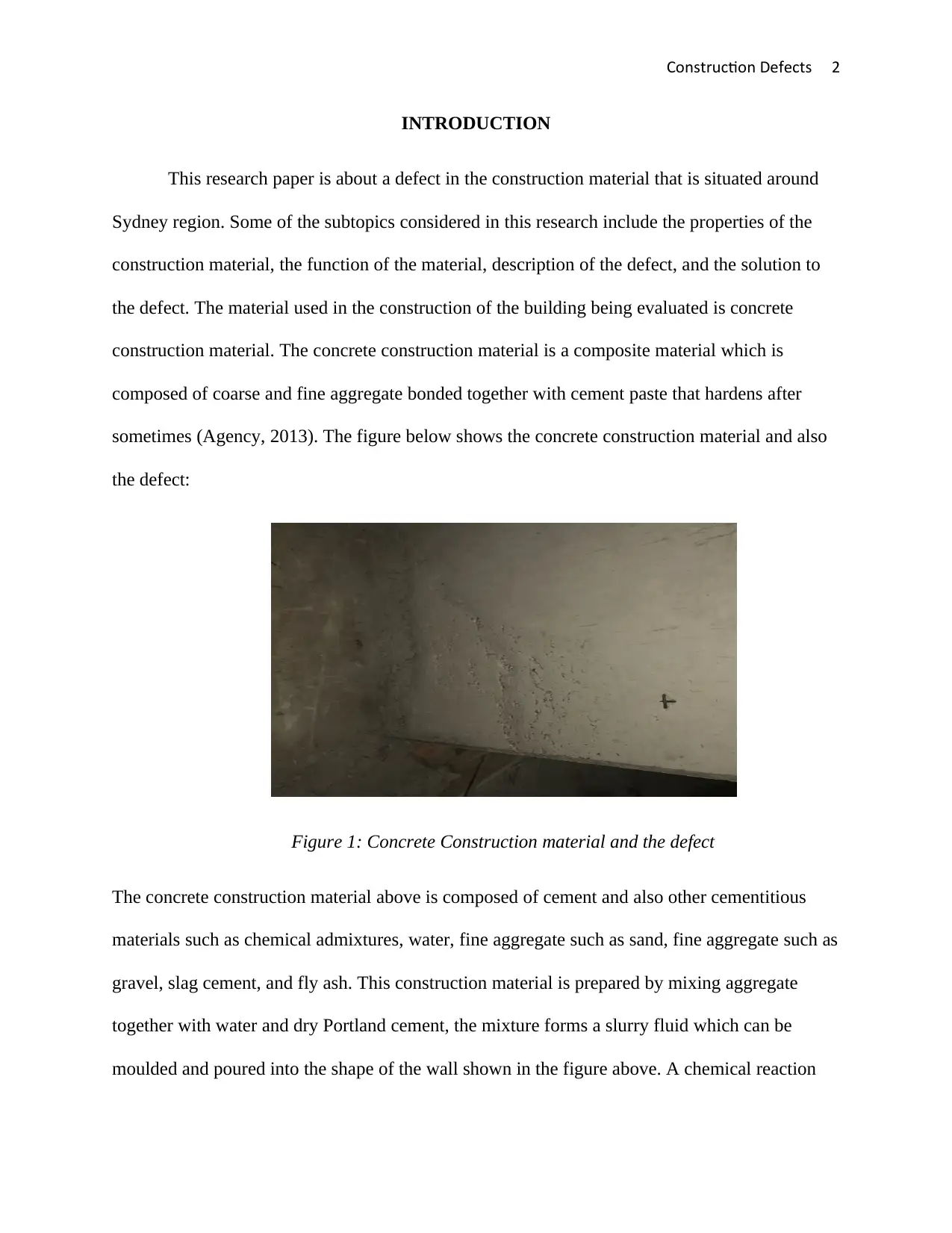
Construction Defects 2
INTRODUCTION
This research paper is about a defect in the construction material that is situated around
Sydney region. Some of the subtopics considered in this research include the properties of the
construction material, the function of the material, description of the defect, and the solution to
the defect. The material used in the construction of the building being evaluated is concrete
construction material. The concrete construction material is a composite material which is
composed of coarse and fine aggregate bonded together with cement paste that hardens after
sometimes (Agency, 2013). The figure below shows the concrete construction material and also
the defect:
Figure 1: Concrete Construction material and the defect
The concrete construction material above is composed of cement and also other cementitious
materials such as chemical admixtures, water, fine aggregate such as sand, fine aggregate such as
gravel, slag cement, and fly ash. This construction material is prepared by mixing aggregate
together with water and dry Portland cement, the mixture forms a slurry fluid which can be
moulded and poured into the shape of the wall shown in the figure above. A chemical reaction
INTRODUCTION
This research paper is about a defect in the construction material that is situated around
Sydney region. Some of the subtopics considered in this research include the properties of the
construction material, the function of the material, description of the defect, and the solution to
the defect. The material used in the construction of the building being evaluated is concrete
construction material. The concrete construction material is a composite material which is
composed of coarse and fine aggregate bonded together with cement paste that hardens after
sometimes (Agency, 2013). The figure below shows the concrete construction material and also
the defect:
Figure 1: Concrete Construction material and the defect
The concrete construction material above is composed of cement and also other cementitious
materials such as chemical admixtures, water, fine aggregate such as sand, fine aggregate such as
gravel, slag cement, and fly ash. This construction material is prepared by mixing aggregate
together with water and dry Portland cement, the mixture forms a slurry fluid which can be
moulded and poured into the shape of the wall shown in the figure above. A chemical reaction
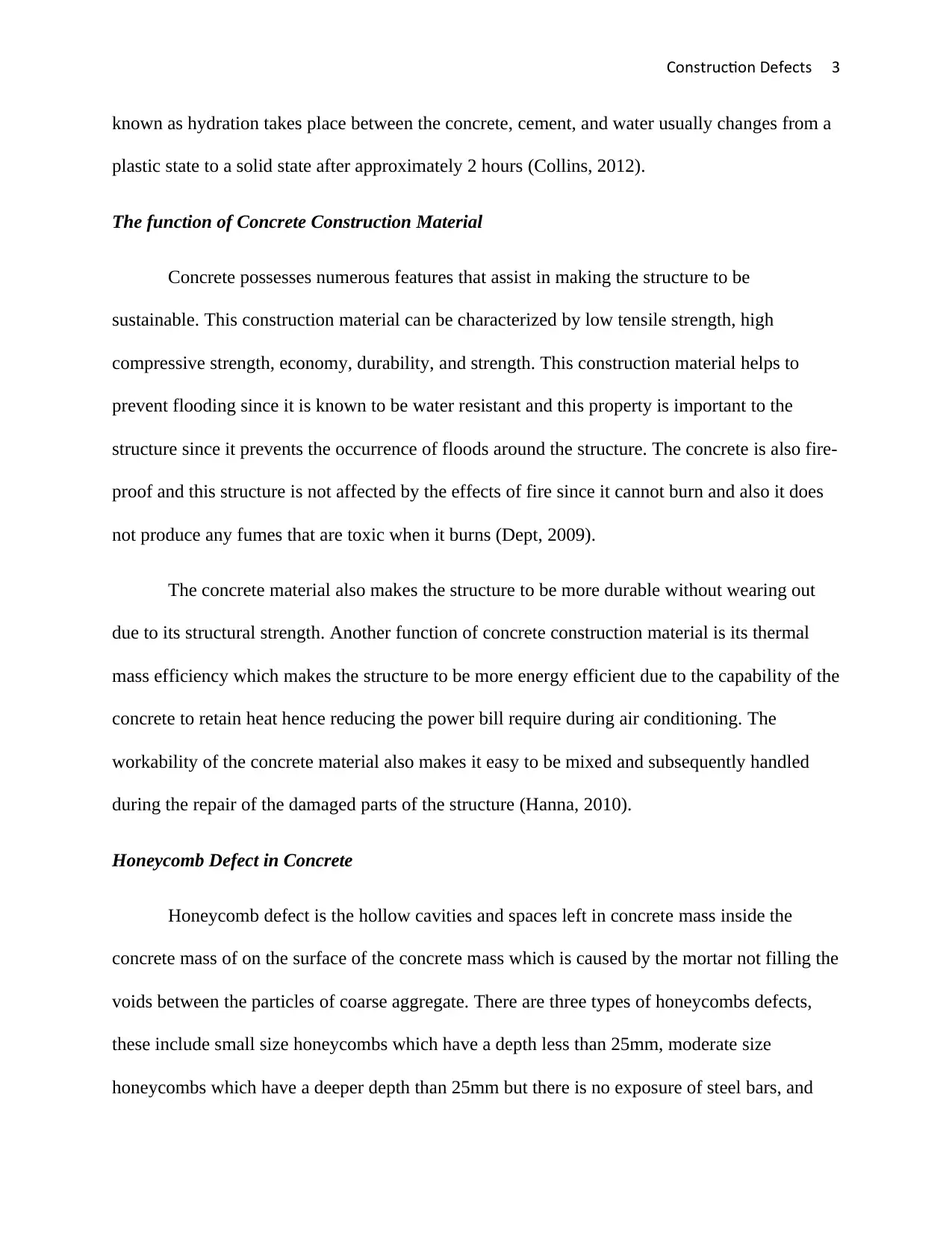
Construction Defects 3
known as hydration takes place between the concrete, cement, and water usually changes from a
plastic state to a solid state after approximately 2 hours (Collins, 2012).
The function of Concrete Construction Material
Concrete possesses numerous features that assist in making the structure to be
sustainable. This construction material can be characterized by low tensile strength, high
compressive strength, economy, durability, and strength. This construction material helps to
prevent flooding since it is known to be water resistant and this property is important to the
structure since it prevents the occurrence of floods around the structure. The concrete is also fire-
proof and this structure is not affected by the effects of fire since it cannot burn and also it does
not produce any fumes that are toxic when it burns (Dept, 2009).
The concrete material also makes the structure to be more durable without wearing out
due to its structural strength. Another function of concrete construction material is its thermal
mass efficiency which makes the structure to be more energy efficient due to the capability of the
concrete to retain heat hence reducing the power bill require during air conditioning. The
workability of the concrete material also makes it easy to be mixed and subsequently handled
during the repair of the damaged parts of the structure (Hanna, 2010).
Honeycomb Defect in Concrete
Honeycomb defect is the hollow cavities and spaces left in concrete mass inside the
concrete mass of on the surface of the concrete mass which is caused by the mortar not filling the
voids between the particles of coarse aggregate. There are three types of honeycombs defects,
these include small size honeycombs which have a depth less than 25mm, moderate size
honeycombs which have a deeper depth than 25mm but there is no exposure of steel bars, and
known as hydration takes place between the concrete, cement, and water usually changes from a
plastic state to a solid state after approximately 2 hours (Collins, 2012).
The function of Concrete Construction Material
Concrete possesses numerous features that assist in making the structure to be
sustainable. This construction material can be characterized by low tensile strength, high
compressive strength, economy, durability, and strength. This construction material helps to
prevent flooding since it is known to be water resistant and this property is important to the
structure since it prevents the occurrence of floods around the structure. The concrete is also fire-
proof and this structure is not affected by the effects of fire since it cannot burn and also it does
not produce any fumes that are toxic when it burns (Dept, 2009).
The concrete material also makes the structure to be more durable without wearing out
due to its structural strength. Another function of concrete construction material is its thermal
mass efficiency which makes the structure to be more energy efficient due to the capability of the
concrete to retain heat hence reducing the power bill require during air conditioning. The
workability of the concrete material also makes it easy to be mixed and subsequently handled
during the repair of the damaged parts of the structure (Hanna, 2010).
Honeycomb Defect in Concrete
Honeycomb defect is the hollow cavities and spaces left in concrete mass inside the
concrete mass of on the surface of the concrete mass which is caused by the mortar not filling the
voids between the particles of coarse aggregate. There are three types of honeycombs defects,
these include small size honeycombs which have a depth less than 25mm, moderate size
honeycombs which have a deeper depth than 25mm but there is no exposure of steel bars, and
⊘ This is a preview!⊘
Do you want full access?
Subscribe today to unlock all pages.

Trusted by 1+ million students worldwide
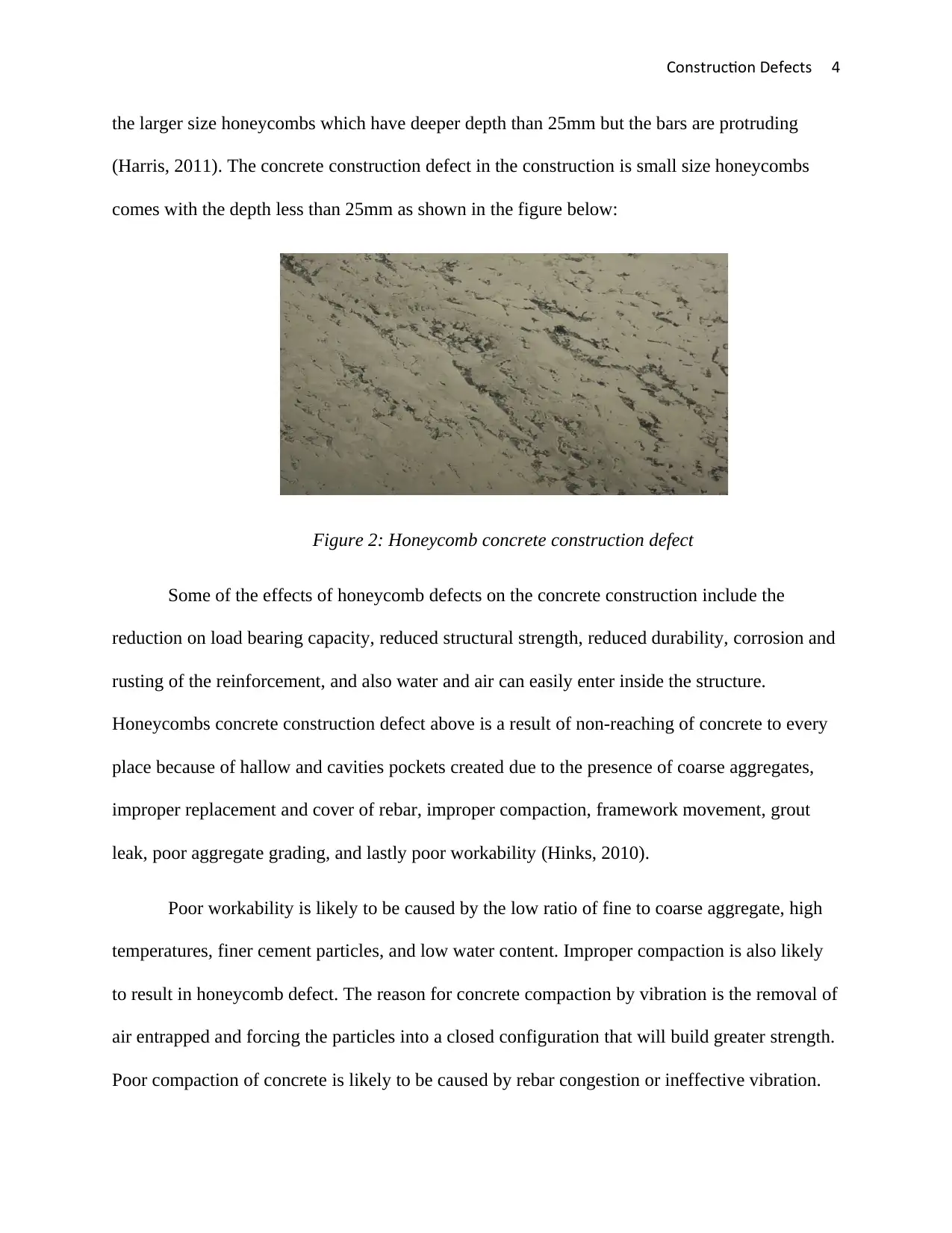
Construction Defects 4
the larger size honeycombs which have deeper depth than 25mm but the bars are protruding
(Harris, 2011). The concrete construction defect in the construction is small size honeycombs
comes with the depth less than 25mm as shown in the figure below:
Figure 2: Honeycomb concrete construction defect
Some of the effects of honeycomb defects on the concrete construction include the
reduction on load bearing capacity, reduced structural strength, reduced durability, corrosion and
rusting of the reinforcement, and also water and air can easily enter inside the structure.
Honeycombs concrete construction defect above is a result of non-reaching of concrete to every
place because of hallow and cavities pockets created due to the presence of coarse aggregates,
improper replacement and cover of rebar, improper compaction, framework movement, grout
leak, poor aggregate grading, and lastly poor workability (Hinks, 2010).
Poor workability is likely to be caused by the low ratio of fine to coarse aggregate, high
temperatures, finer cement particles, and low water content. Improper compaction is also likely
to result in honeycomb defect. The reason for concrete compaction by vibration is the removal of
air entrapped and forcing the particles into a closed configuration that will build greater strength.
Poor compaction of concrete is likely to be caused by rebar congestion or ineffective vibration.
the larger size honeycombs which have deeper depth than 25mm but the bars are protruding
(Harris, 2011). The concrete construction defect in the construction is small size honeycombs
comes with the depth less than 25mm as shown in the figure below:
Figure 2: Honeycomb concrete construction defect
Some of the effects of honeycomb defects on the concrete construction include the
reduction on load bearing capacity, reduced structural strength, reduced durability, corrosion and
rusting of the reinforcement, and also water and air can easily enter inside the structure.
Honeycombs concrete construction defect above is a result of non-reaching of concrete to every
place because of hallow and cavities pockets created due to the presence of coarse aggregates,
improper replacement and cover of rebar, improper compaction, framework movement, grout
leak, poor aggregate grading, and lastly poor workability (Hinks, 2010).
Poor workability is likely to be caused by the low ratio of fine to coarse aggregate, high
temperatures, finer cement particles, and low water content. Improper compaction is also likely
to result in honeycomb defect. The reason for concrete compaction by vibration is the removal of
air entrapped and forcing the particles into a closed configuration that will build greater strength.
Poor compaction of concrete is likely to be caused by rebar congestion or ineffective vibration.
Paraphrase This Document
Need a fresh take? Get an instant paraphrase of this document with our AI Paraphraser
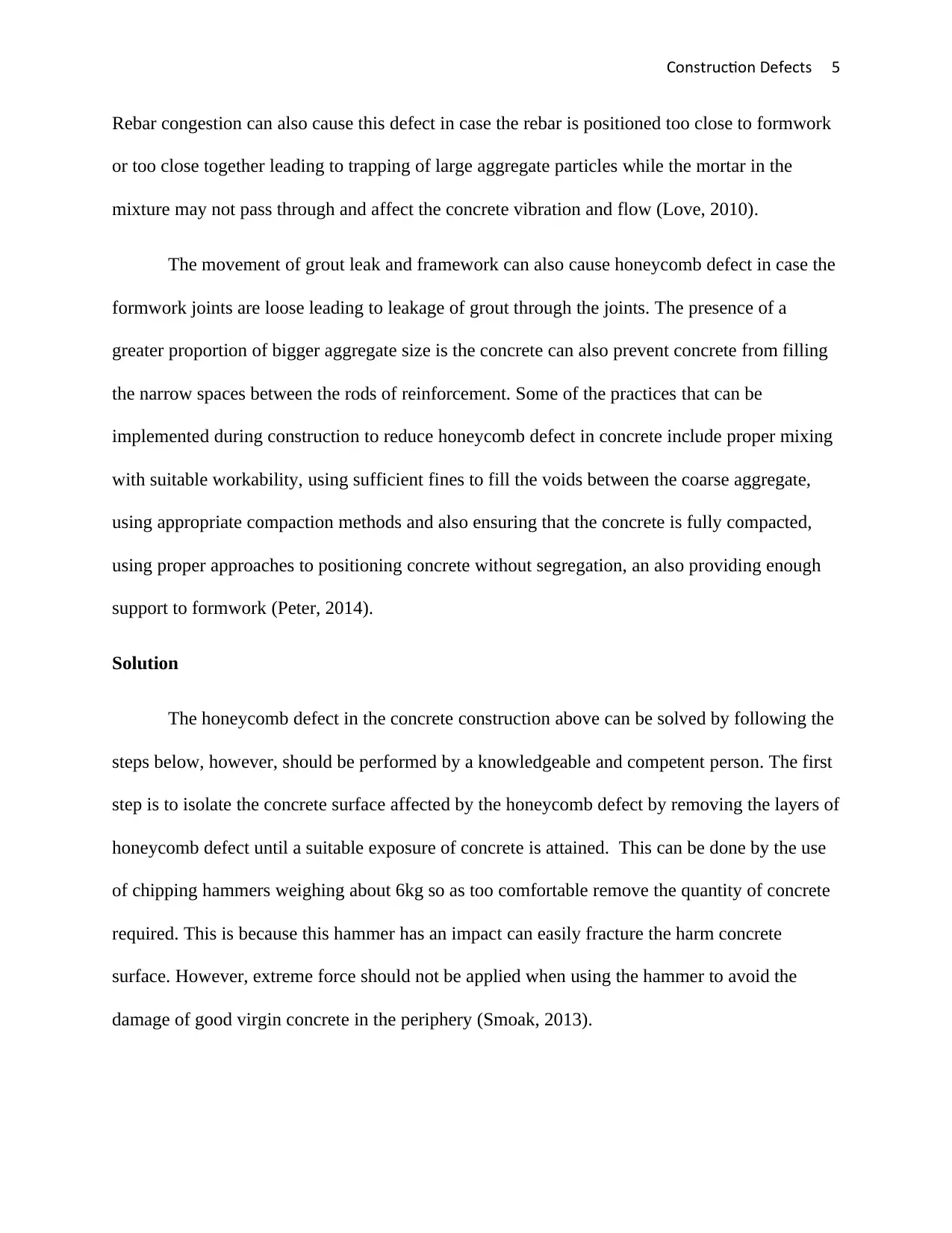
Construction Defects 5
Rebar congestion can also cause this defect in case the rebar is positioned too close to formwork
or too close together leading to trapping of large aggregate particles while the mortar in the
mixture may not pass through and affect the concrete vibration and flow (Love, 2010).
The movement of grout leak and framework can also cause honeycomb defect in case the
formwork joints are loose leading to leakage of grout through the joints. The presence of a
greater proportion of bigger aggregate size is the concrete can also prevent concrete from filling
the narrow spaces between the rods of reinforcement. Some of the practices that can be
implemented during construction to reduce honeycomb defect in concrete include proper mixing
with suitable workability, using sufficient fines to fill the voids between the coarse aggregate,
using appropriate compaction methods and also ensuring that the concrete is fully compacted,
using proper approaches to positioning concrete without segregation, an also providing enough
support to formwork (Peter, 2014).
Solution
The honeycomb defect in the concrete construction above can be solved by following the
steps below, however, should be performed by a knowledgeable and competent person. The first
step is to isolate the concrete surface affected by the honeycomb defect by removing the layers of
honeycomb defect until a suitable exposure of concrete is attained. This can be done by the use
of chipping hammers weighing about 6kg so as too comfortable remove the quantity of concrete
required. This is because this hammer has an impact can easily fracture the harm concrete
surface. However, extreme force should not be applied when using the hammer to avoid the
damage of good virgin concrete in the periphery (Smoak, 2013).
Rebar congestion can also cause this defect in case the rebar is positioned too close to formwork
or too close together leading to trapping of large aggregate particles while the mortar in the
mixture may not pass through and affect the concrete vibration and flow (Love, 2010).
The movement of grout leak and framework can also cause honeycomb defect in case the
formwork joints are loose leading to leakage of grout through the joints. The presence of a
greater proportion of bigger aggregate size is the concrete can also prevent concrete from filling
the narrow spaces between the rods of reinforcement. Some of the practices that can be
implemented during construction to reduce honeycomb defect in concrete include proper mixing
with suitable workability, using sufficient fines to fill the voids between the coarse aggregate,
using appropriate compaction methods and also ensuring that the concrete is fully compacted,
using proper approaches to positioning concrete without segregation, an also providing enough
support to formwork (Peter, 2014).
Solution
The honeycomb defect in the concrete construction above can be solved by following the
steps below, however, should be performed by a knowledgeable and competent person. The first
step is to isolate the concrete surface affected by the honeycomb defect by removing the layers of
honeycomb defect until a suitable exposure of concrete is attained. This can be done by the use
of chipping hammers weighing about 6kg so as too comfortable remove the quantity of concrete
required. This is because this hammer has an impact can easily fracture the harm concrete
surface. However, extreme force should not be applied when using the hammer to avoid the
damage of good virgin concrete in the periphery (Smoak, 2013).
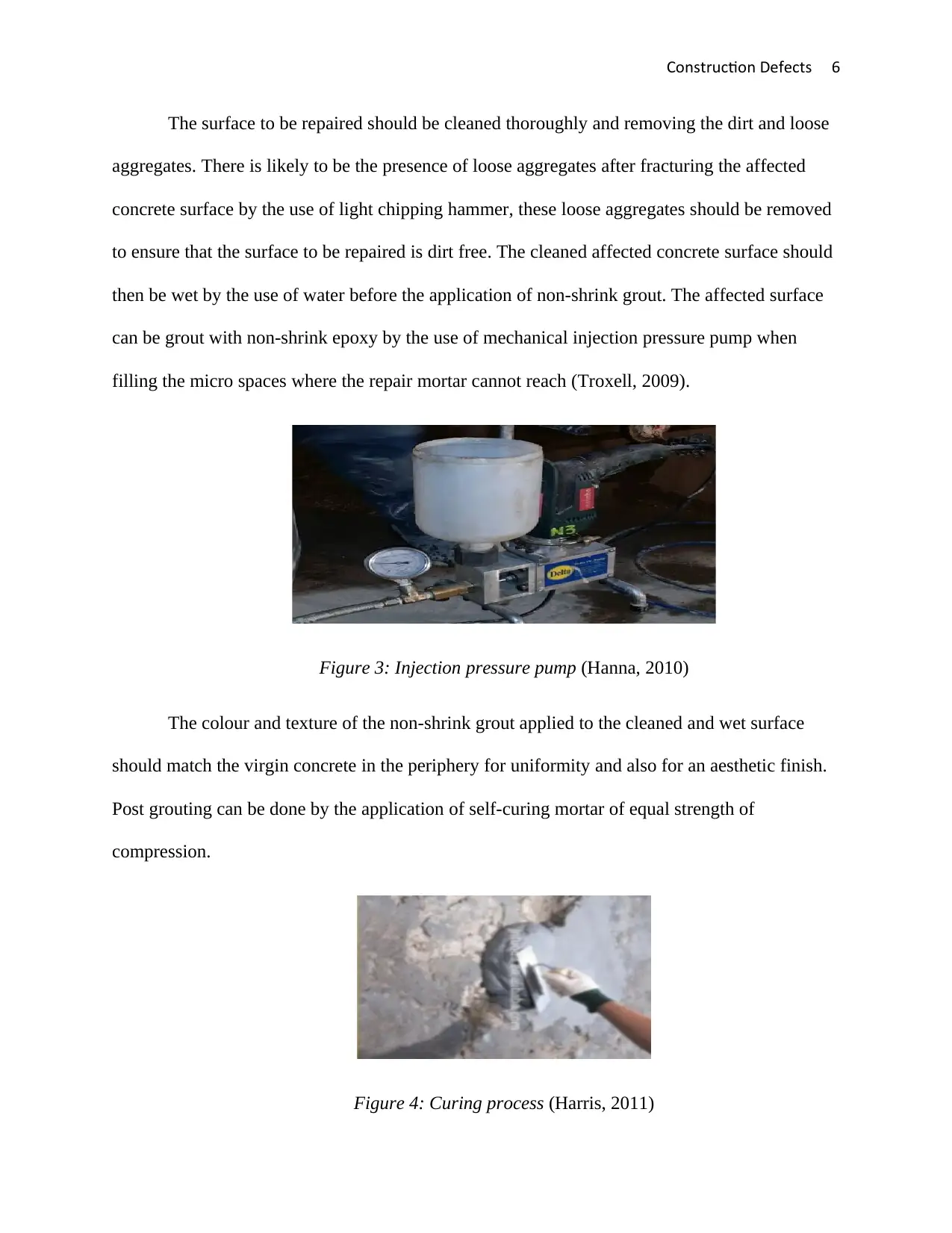
Construction Defects 6
The surface to be repaired should be cleaned thoroughly and removing the dirt and loose
aggregates. There is likely to be the presence of loose aggregates after fracturing the affected
concrete surface by the use of light chipping hammer, these loose aggregates should be removed
to ensure that the surface to be repaired is dirt free. The cleaned affected concrete surface should
then be wet by the use of water before the application of non-shrink grout. The affected surface
can be grout with non-shrink epoxy by the use of mechanical injection pressure pump when
filling the micro spaces where the repair mortar cannot reach (Troxell, 2009).
Figure 3: Injection pressure pump (Hanna, 2010)
The colour and texture of the non-shrink grout applied to the cleaned and wet surface
should match the virgin concrete in the periphery for uniformity and also for an aesthetic finish.
Post grouting can be done by the application of self-curing mortar of equal strength of
compression.
Figure 4: Curing process (Harris, 2011)
The surface to be repaired should be cleaned thoroughly and removing the dirt and loose
aggregates. There is likely to be the presence of loose aggregates after fracturing the affected
concrete surface by the use of light chipping hammer, these loose aggregates should be removed
to ensure that the surface to be repaired is dirt free. The cleaned affected concrete surface should
then be wet by the use of water before the application of non-shrink grout. The affected surface
can be grout with non-shrink epoxy by the use of mechanical injection pressure pump when
filling the micro spaces where the repair mortar cannot reach (Troxell, 2009).
Figure 3: Injection pressure pump (Hanna, 2010)
The colour and texture of the non-shrink grout applied to the cleaned and wet surface
should match the virgin concrete in the periphery for uniformity and also for an aesthetic finish.
Post grouting can be done by the application of self-curing mortar of equal strength of
compression.
Figure 4: Curing process (Harris, 2011)
⊘ This is a preview!⊘
Do you want full access?
Subscribe today to unlock all pages.

Trusted by 1+ million students worldwide
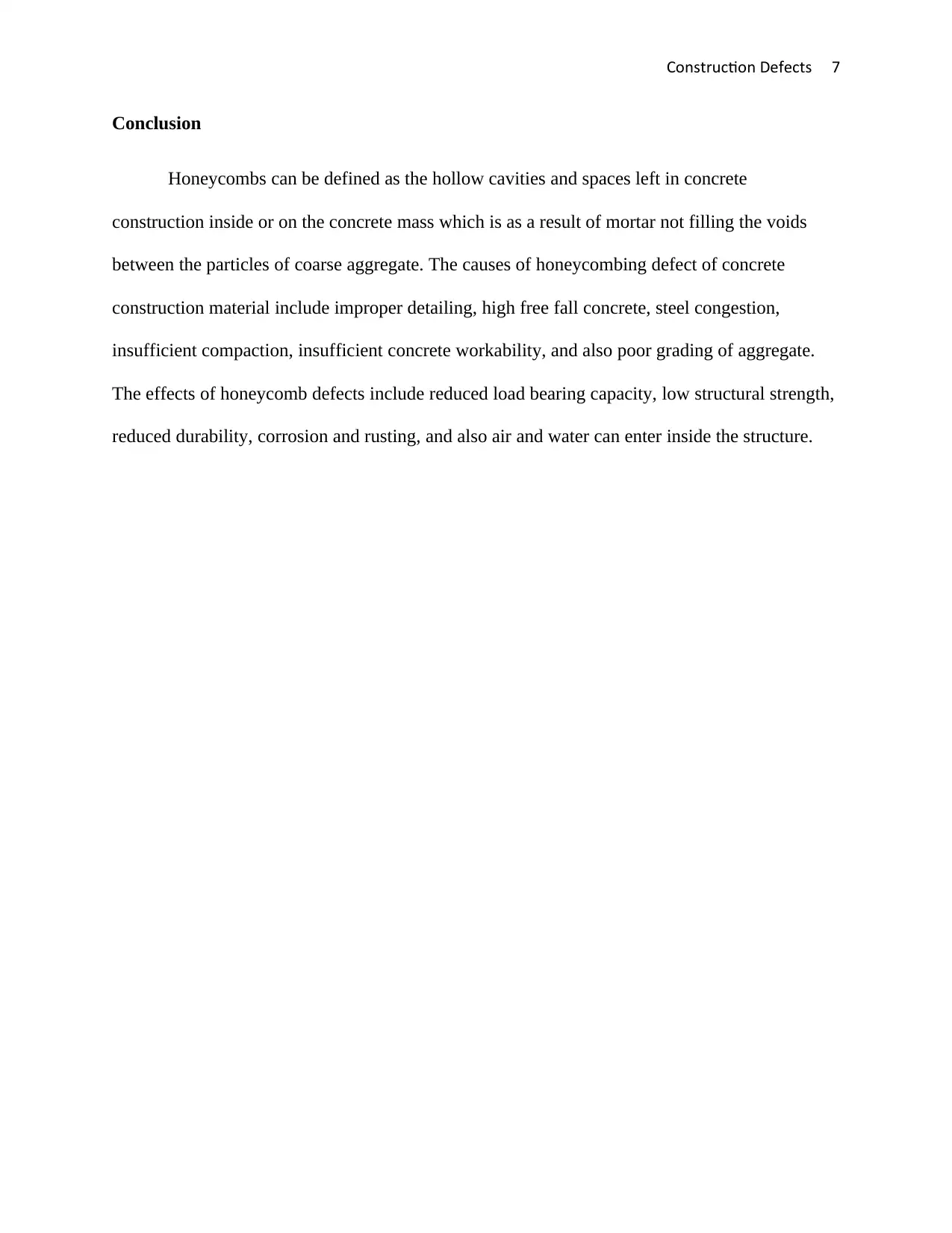
Construction Defects 7
Conclusion
Honeycombs can be defined as the hollow cavities and spaces left in concrete
construction inside or on the concrete mass which is as a result of mortar not filling the voids
between the particles of coarse aggregate. The causes of honeycombing defect of concrete
construction material include improper detailing, high free fall concrete, steel congestion,
insufficient compaction, insufficient concrete workability, and also poor grading of aggregate.
The effects of honeycomb defects include reduced load bearing capacity, low structural strength,
reduced durability, corrosion and rusting, and also air and water can enter inside the structure.
Conclusion
Honeycombs can be defined as the hollow cavities and spaces left in concrete
construction inside or on the concrete mass which is as a result of mortar not filling the voids
between the particles of coarse aggregate. The causes of honeycombing defect of concrete
construction material include improper detailing, high free fall concrete, steel congestion,
insufficient compaction, insufficient concrete workability, and also poor grading of aggregate.
The effects of honeycomb defects include reduced load bearing capacity, low structural strength,
reduced durability, corrosion and rusting, and also air and water can enter inside the structure.
Paraphrase This Document
Need a fresh take? Get an instant paraphrase of this document with our AI Paraphraser
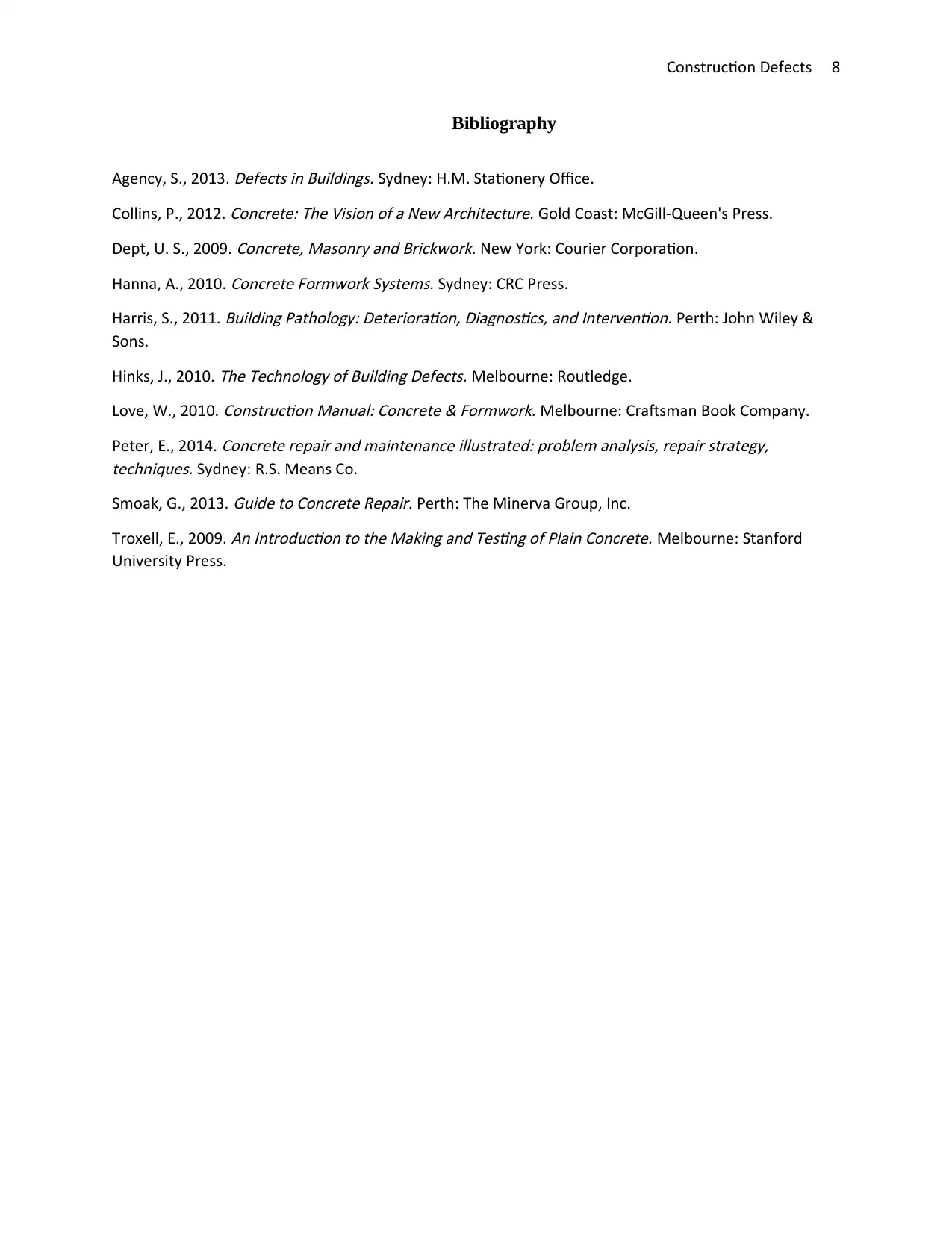
Construction Defects 8
Bibliography
Agency, S., 2013.
Defects in Buildings. Sydney: H.M. Stationery Office.
Collins, P., 2012.
Concrete: The Vision of a New Architecture. Gold Coast: McGill-Queen's Press.
Dept, U. S., 2009.
Concrete, Masonry and Brickwork. New York: Courier Corporation.
Hanna, A., 2010.
Concrete Formwork Systems. Sydney: CRC Press.
Harris, S., 2011.
Building Pathology: Deterioration, Diagnostics, and Intervention. Perth: John Wiley &
Sons.
Hinks, J., 2010.
The Technology of Building Defects. Melbourne: Routledge.
Love, W., 2010.
Construction Manual: Concrete & Formwork. Melbourne: Craftsman Book Company.
Peter, E., 2014.
Concrete repair and maintenance illustrated: problem analysis, repair strategy,
techniques. Sydney: R.S. Means Co.
Smoak, G., 2013.
Guide to Concrete Repair. Perth: The Minerva Group, Inc.
Troxell, E., 2009.
An Introduction to the Making and Testing of Plain Concrete. Melbourne: Stanford
University Press.
Bibliography
Agency, S., 2013.
Defects in Buildings. Sydney: H.M. Stationery Office.
Collins, P., 2012.
Concrete: The Vision of a New Architecture. Gold Coast: McGill-Queen's Press.
Dept, U. S., 2009.
Concrete, Masonry and Brickwork. New York: Courier Corporation.
Hanna, A., 2010.
Concrete Formwork Systems. Sydney: CRC Press.
Harris, S., 2011.
Building Pathology: Deterioration, Diagnostics, and Intervention. Perth: John Wiley &
Sons.
Hinks, J., 2010.
The Technology of Building Defects. Melbourne: Routledge.
Love, W., 2010.
Construction Manual: Concrete & Formwork. Melbourne: Craftsman Book Company.
Peter, E., 2014.
Concrete repair and maintenance illustrated: problem analysis, repair strategy,
techniques. Sydney: R.S. Means Co.
Smoak, G., 2013.
Guide to Concrete Repair. Perth: The Minerva Group, Inc.
Troxell, E., 2009.
An Introduction to the Making and Testing of Plain Concrete. Melbourne: Stanford
University Press.
1 out of 8
Related Documents
Your All-in-One AI-Powered Toolkit for Academic Success.
+13062052269
info@desklib.com
Available 24*7 on WhatsApp / Email
![[object Object]](/_next/static/media/star-bottom.7253800d.svg)
Unlock your academic potential
Copyright © 2020–2025 A2Z Services. All Rights Reserved. Developed and managed by ZUCOL.





